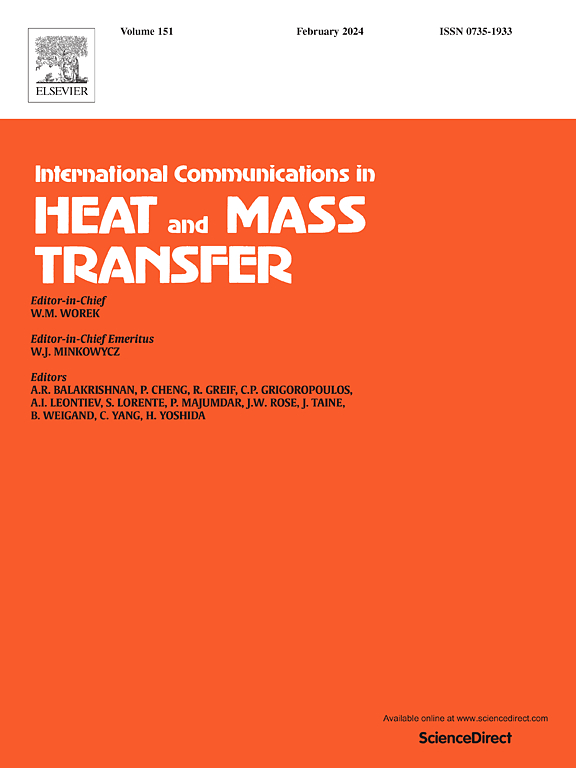Advances and applications of hyperthermia in tumor therapy: Mechanisms, techniques, and clinical integration
IF 6.4
2区 工程技术
Q1 MECHANICS
International Communications in Heat and Mass Transfer
Pub Date : 2025-03-27
DOI:10.1016/j.icheatmasstransfer.2025.108895
引用次数: 0
Abstract
Hyperthermia (HT) has surfaced as a compelling supplementary approach in cancer treatment, owing to its capacity to selectively trigger cell death in tumors and amplify the efficacy of additional therapies. This review examines the most recent progress in hyperthermia methods, encompassing radiofrequency, microwave, focused ultrasound, and innovative approaches enhanced by nanotechnology, such as nano-photo-thermal therapy and nano-magnetic hyperthermia. Each approach utilizes distinct heat-induced mechanisms to directly target tumor cells or modify the tumor microenvironment, influencing aspects such as blood flow, oxygen availability, and the activity of immune cells. The modifications can enhance the effectiveness of chemotherapy and radiotherapy, in addition to emerging immunotherapies such as immune checkpoint inhibitors (ICIs), by leveraging synergistic and immune-activating mechanisms. We investigate the biological foundations of cell death caused by hyperthermia, which encompasses direct thermal injury as well as immunogenic reactions that include damage-associated molecular patterns (DAMPs) and promote the activity of natural killer (NK) cells within the tumor microenvironment (TME). Furthermore, we explore the clinical applications of hyperthermia in different cancer types, focusing on the safety and effectiveness of these approaches, as well as the latest technological innovations that aim to overcome challenges like the heat-sink effect. In conclusion, we present prospective avenues for advancement in hyperthermic tumor ablation, emphasizing enhancements in device technology and the synergy with combination therapies to optimize therapeutic outcomes. This review seeks to deliver an in-depth exploration of the mechanisms behind hyperthermia, its present clinical applications, and its capacity to revolutionize cancer treatment via cutting-edge, multimodal strategies.
热疗在肿瘤治疗中的进展和应用:机制、技术和临床整合
热疗(HT)已成为一种令人信服的癌症治疗补充方法,因为它能够选择性地触发肿瘤细胞死亡,并增强其他疗法的疗效。本文综述了热疗方法的最新进展,包括射频、微波、聚焦超声和由纳米技术增强的创新方法,如纳米光热疗法和纳米磁热疗。每种方法都利用不同的热诱导机制直接靶向肿瘤细胞或改变肿瘤微环境,影响血流、氧气可用性和免疫细胞活性等方面。通过利用协同和免疫激活机制,这些修饰可以增强化疗和放疗的有效性,以及新兴的免疫疗法,如免疫检查点抑制剂(ICIs)。我们研究了由高温引起的细胞死亡的生物学基础,包括直接热损伤以及免疫原性反应,包括损伤相关分子模式(DAMPs)和促进肿瘤微环境(TME)内自然杀伤(NK)细胞的活性。此外,我们探讨了热疗在不同癌症类型中的临床应用,重点关注这些方法的安全性和有效性,以及旨在克服热沉效应等挑战的最新技术创新。总之,我们提出了肿瘤热消融的发展前景,强调了设备技术的改进以及与联合治疗的协同作用,以优化治疗结果。本综述旨在深入探讨热疗背后的机制,其目前的临床应用,以及其通过尖端的多模式策略彻底改变癌症治疗的能力。
本文章由计算机程序翻译,如有差异,请以英文原文为准。
求助全文
约1分钟内获得全文
求助全文
来源期刊
CiteScore
11.00
自引率
10.00%
发文量
648
审稿时长
32 days
期刊介绍:
International Communications in Heat and Mass Transfer serves as a world forum for the rapid dissemination of new ideas, new measurement techniques, preliminary findings of ongoing investigations, discussions, and criticisms in the field of heat and mass transfer. Two types of manuscript will be considered for publication: communications (short reports of new work or discussions of work which has already been published) and summaries (abstracts of reports, theses or manuscripts which are too long for publication in full). Together with its companion publication, International Journal of Heat and Mass Transfer, with which it shares the same Board of Editors, this journal is read by research workers and engineers throughout the world.

 求助内容:
求助内容: 应助结果提醒方式:
应助结果提醒方式:


